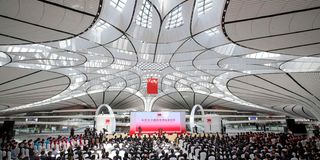Saudi Arabia banks on China to raise its aviation tempo

This general view of the new Beijing Daxing International Airport in Beijing on September 25, 2019. Saudi Arabia is banking on China’s estimated 4 million travellers to help boost the Kingdom’s ambition to be a major tourism and business hub.
Saudi Arabia’s flag carrier is banking on China’s estimated 4 million travellers to help boost the Kingdom’s ambition to be a major tourism and business hub.
Saudia, the Kingdom's national carrier, launched a new direct route from Jeddah to Beijing, its first to China, which means Chinese travellers could arrive in the Kingdom easily to tap into its growing leisure offers, away from the traditional oil business.
On August 4, Airline launched its first direct flights to Beijing. It will fly four times a week. At least 4 million people fly between China and Saudi Arabia annually, officials say. But the Kingdom is using that as a stepping stone into its ‘Wings of Connection’ programme which it will help boost trade and business, tourism, education, and culture.
“It facilitates increased travel, trade, and people-to-people exchanges, fostering stronger bilateral relations,” said Ibrahim Al-Omar, Director General of SAUDIA Group, in a statement.
The new flight, it says, falls in line with Saudi Aviation Strategy, a 2030 vision meant to see Saudi Arabia compete with peers Qatar and the United Arab Emirates who have built aviation hubs over the last two decades.
Under the strategy, Saudi Arabia wants to transport 330 million people annually by 2030 and double its foreign destinations to 250 across the world. Africa and Asia could see most of those flights, according to the strategy launched in May 2022 and could cost $10 billion to achieve.
Traditionally reliant on oil, the Saudi government had, from 2019, upended its economic strategy, choosing to focus on non-oil sectors such as tourism and business travels. Now officials say the Kingdom’s location and available can push through that ambition.
According to the strategy, Saudia, will be “a leading international destination of choice for tourism and business travel, as well as a thriving global logistics hub.”
Part of that, besides expanding its local airports will involve linking its carrier to useful global destinations “accommodating increasing demand from international tourists seeking to discover the treasures of Saudi Arabia.”
But Saudia, one of the oldest airlines in the Middle East, will have to bank on local immigration and other policies back home to thrive. One of the reasons Qatar and UAE have thrived is easier access to visas as well as a liberal market. The Air Connectivity Programme launched two years ago provides certain privileges to those transiting via Saudia such to enable ease of movement.
“By working closely with our partners in the Saudi ecosystem, we have ensured that every traveller embarking on this journey will experience the seamless blend of hospitality, heritage, and innovation Saudi Arabia offers,” said Ali Rajab, Programme’s CEO says.





